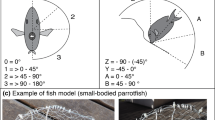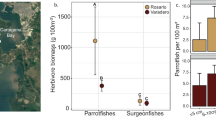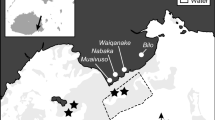Abstract
Herbivory is a significant driver of algal community dynamics on coral reefs. However, abiotic factors such as the complexity and orientation of the benthos often mediate the impact of herbivores on benthic communities. We experimentally evaluated the independent and interactive effects of substrate orientation and herbivorous fishes on algal community dynamics on a coral reef in the Florida Keys, USA. We created horizontal and vertical substrates, mimicking the trend in the reduction of vertical surfaces of coral reefs, to assess how algal communities developed either with herbivory (open areas) or without herbivory (herbivore exclosures). We found that substrate orientation was the dominant influence on macroalgal community composition. Herbivores had little impact on community development of vertical substrates as crustose algae dominated these substrates regardless of being in exclosures or open areas. In contrast, herbivores strongly impacted communities on horizontal substrates, with upright macroalgae (e.g., Dictyota spp., articulated coralline algae) dominating herbivore exclosures, while filamentous turf algae and sediment dominated open areas. Outside of exclosures, differences between vertical and horizontal substrates exposed to herbivores persisted despite similar intensity of herbivory. Our results suggest that the orientation of the reef benthos has an important impact on benthic communities. On vertical surfaces, abiotic factors may be more important for structuring algal communities while herbivory may be more important for controlling algal dynamics in flatter areas. Thus, the decline in structural complexity of Caribbean coral reefs and the flattening of reef substrates may fundamentally alter the impact that herbivores have on benthic community dynamics.





Similar content being viewed by others
Change history
23 October 2018
The article was originally published electronically on the publishers internet portal currently SpringerLink on 14 September 2018 with open access.
References
Adam TC, Burkepile DE, Ruttenberg BI, Paddack MJ (2015a) Herbivory and the resilience of Caribbean coral reefs: knowledge gaps and implications for management. Mar Ecol Prog Ser 520:1–20
Adam TC, Kelley M, Ruttenberg BI, Burkepile DE (2015b) Resource partitioning along multiple niche axes drives functional diversity in parrotfishes on Caribbean coral reefs. Oecologia 179:1173–1185
Alvares-Filip L, Dulvy NK, Gill JA, Cote IM, Watkinson AR (2009) Flattening of Caribbean coral reefs: region-wide declines in architectural complexity. Proc R Soc B 276:3019–3025
Alvares-Filip L, Gill JA, Dulvy NK, Perry AL, Watkinson AR, Cote IM (2011) Drivers of region-wide declines in architectural complexity on Caribbean reefs. Coral Reefs 30:1051–1060
Arnold SN, Steneck RS (2010) Settling into an increasingly hostile world: the rapidly closing “recruitment window” for corals. PLoS One 6:e28681
Birrell CL, McCook LJ, Willis BT (2005) Effects of algal turfs and sediment on coral settlement. Mar Pollut Bull 51:408–414
Blackwood JC, Hasting A, Mumby PJ (2012) The effect of fishing on hysteresis in Caribbean coral reefs. Theor Ecol 5:105–114
Bozec Y-M, Yakob L, Bejarano S, Mumby PJ (2013) Reciprocal facilitation and non-linearity maintain habitat engineering on coral reefs. Oikos 122:428–440
Bozec Y-M, Alvarez-Filip L, Mumby PJ (2015) The dynamics of architectural complexity on coral reefs under climate change. Glob Change Biol 21:223–235
Brandl SJ, Bellwood DR (2016) Microtopography refuges shape consumer-producer dynamics by mediating consumer functional diversity. Oecologia 182:203–217
Brock RE (1979) An experimental study on the effects of grazing by parrotfishes and role of refuges in benthic community structure. Mar Biol 51:381–388
Burdett HL, Keddie V, MacArthur N, McDowall L, Spielvogel E, Hatton AD, Kamenos NA (2014) Dynamic photoinhibition exhibited by red coralline algae in the Red Sea. BMC Plant Biol 139:1–10
Burkepile DE, Hay ME (2007) Predator release of the gastropod Cyphoma gibbosum increases predation on gorgonian corals. Oecologia 154:167–173
Burkepile DE, Allgeir JE, Shantz AA, Pritchard CE, Lemoine NP, Bhatti LH, Layman CA (2013) Nutrient supply from fishes facilitates macroalgae and suppresses corals in a Caribbean coral reef ecosystem. Sci Rep 3:e1493
Carpenter RC (1985) Relationships between primary production and irradiance in coral reef algal communities. Limnol Oceanogr 30:784–793
Carpenter RC (1986) Partitioning herbivory and its effects on coral reef algal communities. Ecol Monogr 56:345–364
Catano LB, Gunn BK, Kelley MC, Burkepile DE (2015) Predation risk, resource quality, and reef structural complexity shape territoriality in a coral reef herbivore. PLoS One 10:e0118764
Catano LB, Rojas MC, Malossi RJ, Peters JR, Heithaus MR, Fourqrean JW, Burkepile DE (2016) Reefscapes of fear: predation risk and reef heterogeneity interact to shape herbivore foraging behavior. J Anim Ecol 85:146–156
Cheroske AG, Williams SL, Carpenter RC (2000) Effects of physical and biological disturbances on algal turfs in Kaneohe Bay, Hawaii. J Exp Mar Biol Ecol 248:1–34
Chiappone M, Rutten LM, Swanson DW, Miller SL (2008) Population status of the urchin Diadema antillarum in the Florida Keys 25 years after the Caribbean mass mortality. In: Proceedings of the 11th international coral reef symposium, NCRI Nova Southeastern University, Dania Beach, USA, pp 712–716
Clausing RJ, Annunziata C, Baker G, Lee C, Bittick SJ, Fong P (2014) Effects of sediment depth on algal turf height are mediated by interactions with fish herbivory on a fringing reef. Mar Ecol Prog Ser 517:121–129
Connell SD, Foster MS, Airoldi L (2014) What are algal turfs? Towards a better description of turfs. Mar EcolProg Ser 495:299–307
Davies SW, Matz MV, Vize PD (2013) Ecological complexity of coral reef recruitment processes: effects of invertebrate herbivores on coral recruitment and growth depends upon substratum properties and coral species. PLoS One 8:e72830
Dean AJ, Steneck RS, Tager D, Pandolfi JM (2015) Distribution, abundance and diversity of crustose coralline algae on the Great Barrier Reef. Coral Reefs 34:581–594
Diaz-Pulido G, McCook LJ (2002) The fate of bleached corals: pattern and dynamics of algal recruitment. Mar Ecol Prog Ser 232:115–128
Doropoulos C, Roff G, Bozec YM, Zupan M, Werminghausen J, Mumby PJ (2016) Characterizing the ecological trade-off throughout the early ontogeny of coral recruitment. Ecol Monogr 86:20–44
Duran A, Collado-Vides L, Burkepile DE (2016) Seasonal regulation of herbivory and nutrient effects on macroalgal recruitment and succession in a Florida coral reef. PeerJ 4:e2643
Edmunds PJ, Nozawa Y, Villanueva RD (2014) Refuges modulate coral recruitment in the Caribbean and the Pacific. J Exp Mar Biol Ecol 454:78–84
Fabricius K, De’ath G (2001) Environmental factors associated with the spatial distribution of crustose coralline algae on the Great Barrier Reef. Coral Reefs 19:303–309
Fabricius K, De’ath G, Noonan S, Uthicke S (2014) Ecological effects of ocean acidification and habitat complexity of reef-associated macroinvertebrate communities. Proc R Soc B 281:20132479
Ferrari R, Gonzalez-Rivero M, Ortiz JC, Mumby PJ (2012) Interaction of herbivory and seasonality on the dynamics of Caribbean macroalgae. Coral Reefs 31:683–692
Goatley CHR, Bellwood DR (2013) Ecological consequences of sediment on high-energy coral reefs. PLoS One 8:e77737
Gordon SE, Goatley CHR, Bellwood DR (2016) Low-quality sediments deter grazing by the parrotfish Scarus rivulatus on inner-self reefs. Coral Reefs 35:285–291
Graham NAJ (2014) Habitat complexity: coral structural loss leads to fisheries declines. Curr Biol 24:359–361
Graham NAJ, Nash KL (2013) The influence of structural complexity in coral reef ecosystems. Coral Reefs 32:315–326
Hata T, Madin JS, Cumbo VR, Denny M, Figueiredo J, Harii S, Thomas CJ, Baird AH (2017) Coral larva are poor swimmers and require fine-scale reef structure to settle. Sci Rep 7:2249
Holbrook SJ, Graham EF, Schmitt RJ (2000) Spatial patterns in abundance of a damselfish reflect availability of suitable habitat. Oecologia 122:109–120
Jackson JBC, Donovan MK, Cramer KL, Lam VV (2014) Status and trends of Caribbean coral reefs: 1970–2012. Global Coral Reef Monitoring Network, IUCN, Gland
Lessios HA (1988) Mass mortality of Diadema antillarum in the Caribbean: what have we learned? Ann Rev Ecol Syst 19:371–393
Lewis SM, Wainwright PC (1985) Herbivore abundance and grazing intensity on a Caribbean coral reef. J Exp Biol Ecol 87:215–228
Littler MM, Littler DS (2013) The nature of crustose coralline algae and their interactions on reefs. Smithson Contrib Mar Sci 39:199–212
Luckhurst BE, Luckhurst K (1978) Analysis of the influence of substrate variables on coral reef fish communities. Mar Biol 49:317–323
Mallela J (2018) The influence of micro-topography and external bioerosion on coral-reef-building organisms: recruitment, community composition and carbonate production over time. Coral Reefs 37:227–237
Mapstone BD, Andrew NL, Chancerell Y, Salvat B (2007) Mediating effects of sea urchins on interactions among corals, algae and herbivorous fish in the Moore lagoon, French Polynesia. Mar Ecol Prog Ser 332:143–153
Miller MW, Hay ME, Miller SL, Malone D, Sotka EE, Szmant AM (1999) Effects of nutrients versus herbivores on reef algae: a new method for manipulating nutrient on coral reefs. Limnol Oceanogr 44:1847–1861
Ogden JC, Lobel PS (1978) The role of herbivorous fishes and urchins in coral reef communities. Env Biol Fish 3:49–63
Oksanen J, Blanchet FG, Friendly M, Kindt R, Legendre P, McGlinn D, Minchin PR, O’hara RB, Simpson GL, Solymos P et al (2017) Community ecology package. R package version 2.3-2. http://CRAN.R-project.org/package=vegan
Perry CT, Murphy GN, Kench PS, Edinger EN, Smithers SG, Steneck RS, Mumby PJ (2014) Changing dynamics of Caribbean reef carbonate budget: emergence of reef bioeroders as critical controls on present and future reef growth potential. Proc R Soc B 281:20142018
Ritson-Williams R, Arnold SN, Paul VJ (2016) Patterns of larvae settlement preferences and post-settlement survival for seven Caribbean corals. Mar Ecol Prog Ser 548:127–138
Roff G, Zhao J-X, Mumby PJ (2015) Decadal-scale rates of reef erosion following El Nino-related mass coral mortality. Glob Change Biol 21:4415–4424
Rogers A, Blanchard JL, Mumby PJ (2014) Vulnerability of coral reef fisheries to a loss of structural complexity. Curr Biol 24:1000–1005
Smith JE, Smith CM, Hunter CL (2001) An experimental analysis of the effects of herbivory and nutrient enrichment on benthic community dynamics on a Hawaiian reef. Coral Reefs 19:332–342
Smith JE, Hunter CL, Smith CM (2010) The effects of top-down versus bottom-up control on benthic coral reef community structure. Oecologia 163:497–507
Soren H (2016) Grouping statistics, LS means, linear contrasts, utilities. R package version 3.2.0. http://CRAN.R-project.org/package=doBy
Steneck RS (1983) Quantifying herbivory on coral reefs: just scratching the surface and still biting off more than we can chew. In: Reaka L (ed) The ecology of deep and shallow coral reefs. Symposia series for undersea research, vol 1. National Oceanic and Atmospheric Administration, Rockville, Maryland, USA, pp 103–111
Steneck RS (1986) The ecology of coralline algal crusts: convergent patterns and adaptive strategies. Ann Rev Ecol Syst 17:273–303
Steneck RS (1997) Crustose corallines, other algal functional groups, herbivores and sediments: complex interactions along reef productivity gradients. In: proceedings of the 8th international coral reef symposium, Panama City, Panama, pp 675–700
Steneck RS, Dethier MN (1994) A functional group approach to the structure of algal-dominated communities. Oikos 69:476–498
Strader ME, Davies SW, Matz MV (2015) Differential responses of coral larvae to the colour of ambient light guide them to suitable settlement microhabitat. R Soc Open Sci 2:150358
R Core Team (2016) R: a language and environment for statistical computing. R Foundation for Statistical Computing, Vienna. http://www.R-project.org/ (ISBN: 3-900051-07-0)
Tebbett SB, Goatley CHR, Bellwood DR (2017) The effects of algal turf sediments and organic loads on feeding by coral reef surgeonfishes. PLoS One 12:e0169479
Trapon ML, Pratchett MS, Hoey AS (2013a) Spatial variation in abundance, size and orientation of juvenile corals related to the biomass of parrotfishes on the Great Barrier Reef, Australia. PLoS One 8:e57788
Trapon ML, Pratchett MS, Hoey AS, Baird AH (2013b) Influence of fish grazing and sedimentation on the early post-settlement survival of the tabular coral Acropora cytherea. Coral Reefs 32:1051–1059
Venables WN, Ripley BD (2002) Modern applied statistics with S, 4th edn. Springer, New York, p 495
Verges AM, Vanderklift A, Doropoulos C, Hyndes GA (2011) Spatial patterns in herbivory on a coral reef are influenced by structural complexity but not algal trait. PLoS One 6:e17115
Vermeij MJA (2006) Early life-history dynamics of Caribbean coral species on artificial substratum: the importance of competition, growth and variation in life-history strategy. Coral Reefs 25:59–71
Whalan S, Wahab MAA, Sprungala S, Poole AJ, de Nys R (2015) Larval settlement: the role of surface topography for sessile coral reef invertebrates. PLoS One 10:e117675
Wickham H (2009) Ggplot2: elegant graphics for data analysis. Springer, New York, p 211
Wilson SK, Graham NAJ, Polunin NVC (2007) Appraisal of visual assessments of habitat complexity and benthic composition on coral reefs. Mar Biol 151:1069–1076
Zaneveld JR, Burkepile DE, Shantz AA, Pritchard CE, McMinds R, Payet JP, Welsh R, Correa AMS, Lemoine NP, Rosales S, Fuchs C, Maynard J, Vega-Thurber R (2016) Overfishing and nutrient pollution interact with temperature to disrupt coral reefs down to microbial scales. Nat. Commun 7:11833
Acknowledgements
We appreciate the valuable comments and suggestions provided by several anonymous reviewers as well as Alastair Harborne and Andy Shantz that helped to improve the manuscript. Additionally, we want to thank Mark Ladd and Andy Shantz for their help in the field setting up the experiment. We also want to thank members of the FIU marine macroalgae research lab and the Burkepile Lab at UCSB that collaborated with field data collection, in particular, Amanda Brannon and Alexandra Simmons. This is contribution #105 from the Center for Coastal Oceans Research in the Institute of Water and Environment at Florida International University.
Funding
This work was facilitated by Grant OCE 1130786 from the National Science Foundation to D.E. Burkepile. The funders had no role in study design, data collection, and analysis, decision to publish, or preparation of the manuscript.
Author information
Authors and Affiliations
Corresponding author
Ethics declarations
Ethical approval
The authors declare that all applicable international, national and/or institutional guidelines for sampling, care and experimental use of organisms for the study have been followed and all necessary approvals have been obtained.
Conflict of interest
The authors declare that they have no conflict of interest.
Additional information
Responsible Editor: P. Kraufvelin.
Reviewed by V. Jormalainen and an undisclosed expert.
The original version of this article was revised: due to a retrospective Open Access cancellation.
Electronic supplementary material
Below is the link to the electronic supplementary material.
Rights and permissions
About this article
Cite this article
Duran, A., Collado-Vides, L., Palma, L. et al. Interactive effects of herbivory and substrate orientation on algal community dynamics on a coral reef. Mar Biol 165, 156 (2018). https://doi.org/10.1007/s00227-018-3411-2
Received:
Accepted:
Published:
DOI: https://doi.org/10.1007/s00227-018-3411-2




